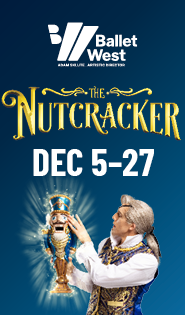Guangdong Modern Dance shows its range, versatility with “Beyond Calligraphy”

Guangdong Modern Dance Company (GMDC) brought its acclaimed performance Beyond Calligraphy, choreographed in 2005 by Liu Qi, to Kingsbury Hall as part of UtahPresents on Tuesday night. Although its name includes the words “modern dance,” GMDC blends a variety of movement techniques, from ballet to martial arts, and its dancers perform with stunning clarity and precision.
Beyond Calligraphy exhibits the troupe’s impressive range of styles. The two-act production suggests a journey from mechanical, assertive, and staccato choreography in the first half, “Upon Calligraphy,” to a multimedia second half, called “Ink Wash Landscape.” The music, composed by Dickson Dee (Li Chin Sung), matches the dancers’ movement qualities with clanging sounds, squeaks, and rattles in the first act, followed by more harmonious and soothing acoustics after intermission. Costumes designed by WU Bing feature monochromatic ensembles, with the cast of 13 in either black, white, or grey outfits.
The production’s projections reinforce the contrasts of the two-part structure of Beyond Calligraphy, juxtaposing robotic and acrobatic interactions during the first half with more sensuous, slow-moving montages in part two. The performance begins with Chinese characters scrolling across the backdrop; in the second half, the projections feature natural landscapes such as mountains, trees, aquatic life, and desert. At times these images merge with the dancers’ bodies, making it appear as if their torsos are imprinted with Chinese characters, or camouflaged with blossoming trees. These moments are evocative and distinguish themselves from other sections that tend to rely on a formulaic progressions of canon and unison movement phrases.
No matter what the choreography, the dancers perform with stellar commitment and power. “Upon Calligraphy” includes an array of angular shapes: bent knees, flexed feet, and arms that make perpendicular angles. The dancers’ individual shapes suggest hieroglyphics and together they form abstract, interlocking phrases. Wrists and hands carve through the air with exquisite attention to detail.
A section for five bare-chested men, wearing black, wide-legged, capri-length pants, exhibits their physical feats. They repeat a stunning descent where their legs fold underneath them, and they land in a seated position.
In contrast, the choreography for the female dancers tends to be more delicate and sensual. If, at times, the movement vocabulary becomes predictable, the dynamic shifts in the acoustic score, along with changes in costume, enrich the contrasts between each scene.
The second act, “Ink Wash Landscape,” tests the capacity of the dancers to move as slowly as possible. They appear like statues being blown by wind or majestic ghosts gliding through a landscape. Long, white dresses for the women enhance the meditative quality of this section. The final image of Beyond Calligraphy has the cast in a cluster, slowing melting to the ground, and then the lights fade.
This connection with the earth, and the visual projections that showed respect for different landscapes, recalled the Land Acknowledgement that Brooke Horejsi, executive director of UtahPresents, delivered at the start of the evening. Horejsi honored the Indigenous Nations that are traditional stewards of this land. The urgency of caring for our environment, and creating sustainable relationships with one another, echoed through the second half of Beyond Calligraphy.
Founded in 1992, GMDC is regarded as the first professional dance company in China and shows how modern dance adapts to the cultures and histories of the places where it is performed. If modern dance in the United States grew throughout the 20th century by individual choreographers inventing their own movement techniques––Isadora Duncan, Martha Graham, Katherine Dunham, Lester Horton, José Limón, Merce Cunningham––GMDC features an eclectic range of styles and a commitment to unity. Instead of emphasizing one distinct technique, the dancers excel in a spectrum of practices, and are unified by their excellence in each one. Their performance encourages an appreciation of cultural differences that can co-exist and complement one another.
Prior to the performance by GMDC, UtahPresents hosted a calligraphy demonstration for patrons, in collaboration with the Confucius Institute. Led by Xie Feidong, this event revealed how characters have evolved over time, and how facial expressions connect to character’s pronunciation. It was a fascinating glimpse into links between language and movement, and their symbiotic evolutions, themes that were extended into the performance of Beyond Calligraphy.


